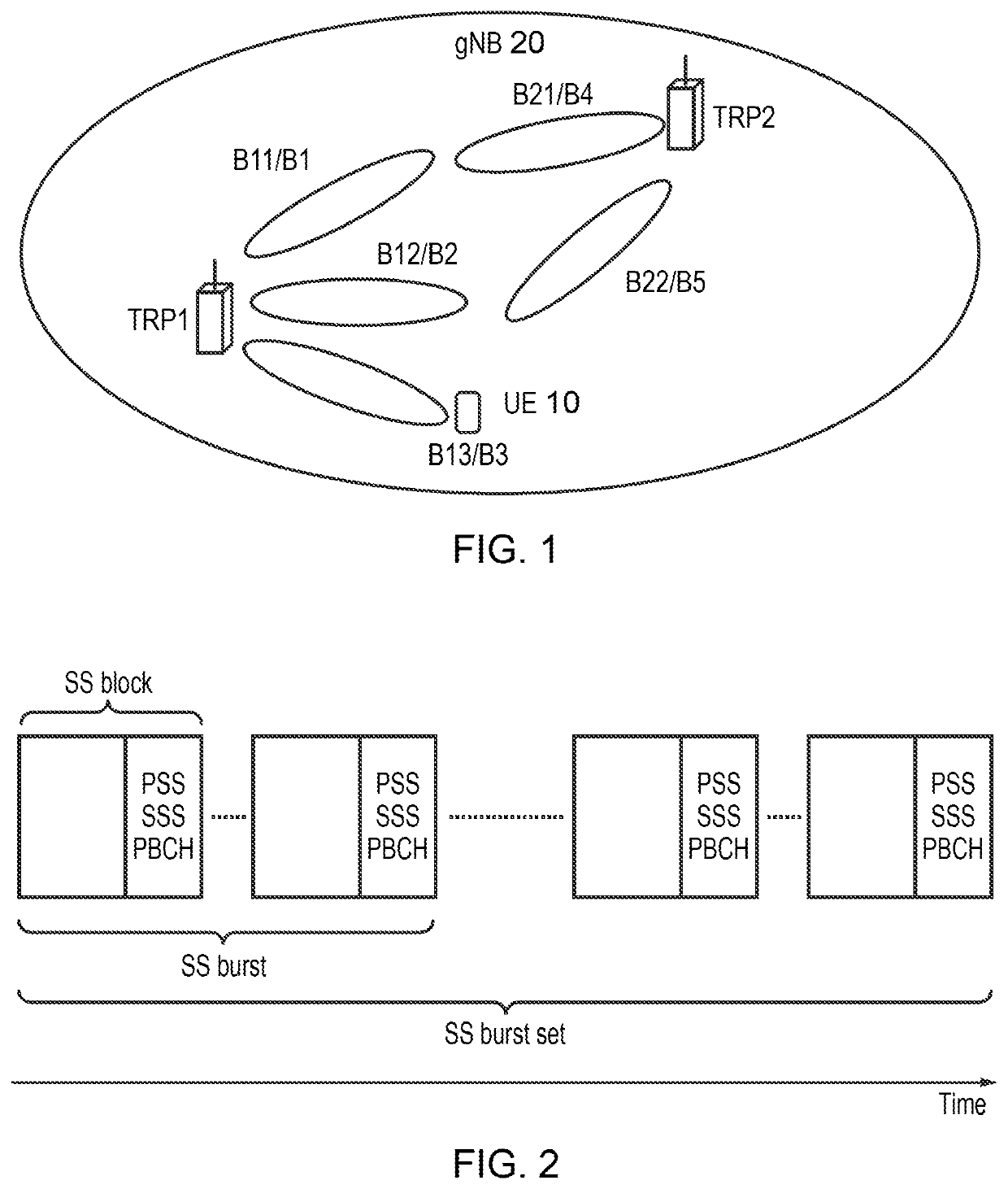Synchronization and Broadcast Signal Design for 5G
a broadcast signal and synchronization technology, applied in the field of wireless communication methods, can solve the problems of huge technical challenges, extremely low latency and high reliability services, and significant challenges to the current wireless system, and achieve the effects of significant capacity, power consumption, spectral efficiency and interference improvemen
- Summary
- Abstract
- Description
- Claims
- Application Information
AI Technical Summary
Benefits of technology
Problems solved by technology
Method used
Image
Examples
first embodiment
[0119]Based on the assumption that an identical PBCH is transmitted by each beam, a first embodiment is to use SSS to transmit the beam ID. As variations of this embodiment the beam ID may be constructed in different ways, for example:—[0120](a) A unique beam ID is defined for each beam provided by a gNB, independent of the cell. For example in FIG. 1 the beams from TRP 1 are numbered B1, B2 and B3 and those from TRP2 continue the same numbering sequence as B4 and B5.[0121](b) A beam ID is composed of its cell identity plus its beam identity within the cell. For example in FIG. 1 the second beam from TRP1 may be expressed as Bc2 where c is the cell ID. In the case a subset of the unique beams available in the system may be associated with a particular cell (or vice versa).[0122](c) A beam ID is composed of its TRP identity plus its beam identity within this TRP. For example in FIG. 1 the second beam from TRP1 may be expressed as B12 where in beam ID Bxy, x represents the number of T...
second embodiment
[0133]As already mentioned, conventionally, in LTE a UE needs its cell ID to deduce the location of the reference symbols embedded in the PBCH signal. A UE will further use the cell ID to decode these reference symbols, and then it can further decode the PBCH signal. A second embodiment of the present invention, which may be an extension of the first embodiment, employs special, cell ID independent, or partially cell ID independent, reference signals, and the PBCH signal is decoded based on these reference signals. Then a UE can decode PBCH signal without the knowledge (or full knowledge) of the cell ID, although the cell ID could still be transmitted on every beam. In this way, cell ID decoding can be decoupled from PBCH decoding in order to provide more design flexibility and ensure forward compatibility.
[0134]To implement this embodiment, one solution is to introduce special demodulation reference signals (which we denote here as “PBCH DM RS”) for PBCH decoding. With this solutio...
third embodiment
[0141]The third embodiment is to transmit beam ID by using PBCH. This is primarily envisaged as an alternative to the first embodiment, although it might be possible to combine both embodiments for providing beam ID redundantly (e.g. providing a cross-check of correct reception), or to use the different embodiments to transmit different parts of a beam ID. It was agreed in the above mentioned 3GPP RAN1 87 meeting report, Reno, USA 14th-18th November, USA that the NR PBCH is a non-scheduled broadcast channel carrying at least a part of minimum system information with fixed payload size and periodicity predefined in the specification depending on carrier frequency range. However what information can be classified as minimum system information is still under investigation. A concrete implementation is to include beam ID information in the PBCH information. In LTE the MIB, which is the message transmitted by PBCH, consists of 24 bits where there are 10 spare bits for future use. Using a...
PUM
 Login to View More
Login to View More Abstract
Description
Claims
Application Information
 Login to View More
Login to View More - R&D
- Intellectual Property
- Life Sciences
- Materials
- Tech Scout
- Unparalleled Data Quality
- Higher Quality Content
- 60% Fewer Hallucinations
Browse by: Latest US Patents, China's latest patents, Technical Efficacy Thesaurus, Application Domain, Technology Topic, Popular Technical Reports.
© 2025 PatSnap. All rights reserved.Legal|Privacy policy|Modern Slavery Act Transparency Statement|Sitemap|About US| Contact US: help@patsnap.com



